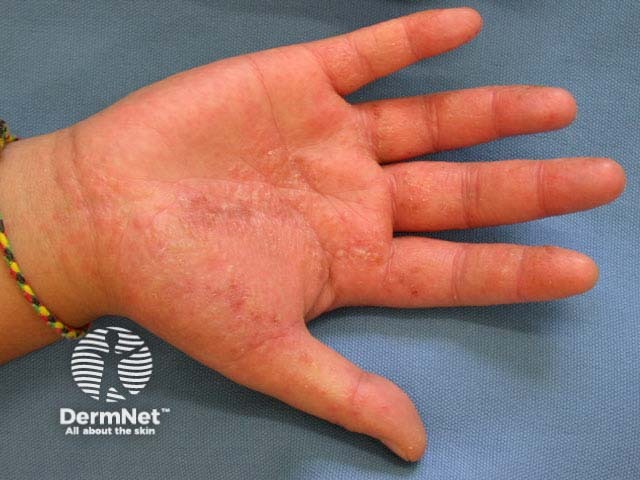Main menu
Common skin conditions

NEWS
Join DermNet PRO
Read more
Quick links
For each of the ten cases, study the image(s) and then answer the questions. You can click on the image to view a larger version if required.
Each case should take approximately 2 minutes to complete. There is a list of suggested further reading material at the end of the quiz.
When you finish the quiz, you can download a certificate.

What is the diagnosis?
Pompholyx, also known as dyshidrotic eczema, which is one form of vesicular palmar dermatitis.
What clinical features distinguish this from other hand rashes?
Pompholyx or dyshidrotic eczema presents as recurrent crops of intensely pruritic vesicles on the palms and sides of the fingers (cheiropompholyx) and/or soles and toes (pedopompholyx). It tends to affect young adults and may be provoked by stress, possibly through increasing eccrine sweat production. As the vesicles dry up, the affected skin peels and fissures. It is considered an endogenous form of eczema.
Pompholyx may be confused with localised pustular psoriasis (palmar pustulosis) in which there are clusters of yellow sterile pustules and brown dried up spots, usually within a well-demarcated erythematous plaque. Pompholyx and localised pustular psoriasis may co-exist.
What diagnostic tests are available?
Pain, pustules or crusting suggest secondary infection with Staphylococcus aureus and/or beta haemolytic Streptococcus, common in pompholyx and absent in pustular psoriasis despite the pustules. Swabs may be appropriate to confirm the presence of bacterial infection and select appropriate antibiotic therapy.
Consider scabies: look for burrows (dermoscopy helps) and attempt to extract a mite if these are present.
Pompholyx can arise as an ide response to tinea pedis; palmar scrapings are negative but dermatophyte can be cultured from the feet.
Patch testing is a specialist tool to determine whether the patient has allergy to materials with which she is in contact. Contact allergy may co-exist with pompholyx.
What treatment should be recommended?
During the acute blistering stage, treat with wet dressings and ultrapotent topical steroids. During the subsequent dry phase, use plenty of emollients. Protect from injury and contact factors such as friction, water, detergents and solvents. Severe pompholyx may require systemic steroids for a few days, repeated as necessary.
Recurrent or persistent pompholyx interfering with function may require specialist consultation and second line treatments. These may include phototherapy, acitretin, methotrexate or azathioprine.